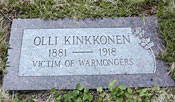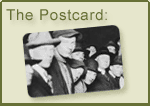|
|||||||||||||||
|
The Story
Resources
Background
|
By Chris Julin, Minnesota Public Radio
June 2001
|
|
RealAudio |

|
|
|
The grave marker of Olli Kinkonnen, a Finnish immigrant who was hanged in Duluth in 1918. His grave, in Park Hill Cemetery in Duluth, is just a few rows down from those of the three black victims of the 1920 lynching. (MPR Photo/Stephanie Hemphill) |
In September 1918, the end of World War I was only two months away, but fighting was still fierce in Europe. The Duluth News Tribune and the Duluth Herald were filled with dispatches from the front lines, and full-page ads for war bonds, and long lists of servicemen who'd been killed. The papers were also full of tough talk about "slackers," a term for men who refused to join the military.
Toward the end of September, the tough talk turned to action. A headline in the Duluth Herald read, "Knights Of Liberty Tar And Feather Slacker." The story told of a Finnish immigrant, Olli Kinkkonen, who'd been dragged from a Duluth boarding house the night before, and not seen again. A phone call, and a letter delivered to the paper, took credit for the abduction in the name of a group calling itself the "Knights of Liberty." The letter said Kinkkonen had been tarred and feathered to serve as a warning to all slackers. Kinkkonen never showed up again at his boarding house, and his body was discovered almost two weeks later, dangling from a tree just outside of town, near Lester Park - covered with tar and feathers.
Duluth authorities declared the death a suicide. They said Kinkkonen was humiliated by the tarring, and hanged himself. Donald Wirtanen disagrees. "He was lynched," says Wirtanen, a retired businessman from Duluth, and the former honorary Finnish consul here.
Wirtanen grew up in a small Iron Range town called Markham, and moved to Duluth as a young man. He says most Finnish people in northern Minnesota in 1918 believed Olli Kinkkonen was murdered. Wirtanen was only five years old at the time, but he remembers his parents talking about it.
|
" He was an anti-war Finn. In northeast Minnesota, to be an anti-war Finn at that time was to be perceived as a subversive. Mr. Kinkkonen probably received this less for what he did, than what he symbolized in the eyes of so-called patriotic Americans. " - Historian Joel Sipress
|
Historian Joel Sipress from the University of Wisconsin-Superior says it was a violent time. "If you were the right kind of person, who killed the right kind of person, you could get away with murder," says Sipress.
Newspapers of the era tell of many attacks on union leaders and immigrants. But old-timers in Duluth's Finnish community say Olli Kinkkonen didn't belong to any labor organizations or anti-war groups. They say he was a quiet working man - a logger and a dock worker - who didn't want to fight in the war, and decided to go back to Finland. They think his attackers believed he was someone else - a more vocal and radical Finn.
But it's possible the people who tarred and feathered Olli Kinkkonen didn't care whether he was a leader. Historian Joel Sipress says anti-Finnish sentiment was powerful in this region in 1918.
"He was a Finn," Sipress says of Kinkkonen, "and he clearly was an anti-war Finn. In northeast Minnesota, to be an anti-war Finn at that time was to be perceived as a subversive. Finnish workers were among the most active in the radical labor organizing of those days, and the union efforts on the Iron Range. Mr. Kinkkonen probably received this less for what he did, than what he symbolized in the eyes of so-called patriotic Americans."
No one faced charges for Olli Kinkkonen's abduction and death.
Kinkkonen was buried in an unmarked grave in a poor people's section of Park Hill Cemetery, just a few rows away from the graves of the three victims of the 1920 Duluth lynching. The Tyomies Society, a Finnish cultural group, placed a marker on Kinkkonen's grave in 1993. It reads, "Olli Kinkkonen, 1881 to 1918, Victim of Warmongers."
Return to Postcard From A Lynching Home
More Background
Finland Was a Poor Country, MPR Project

